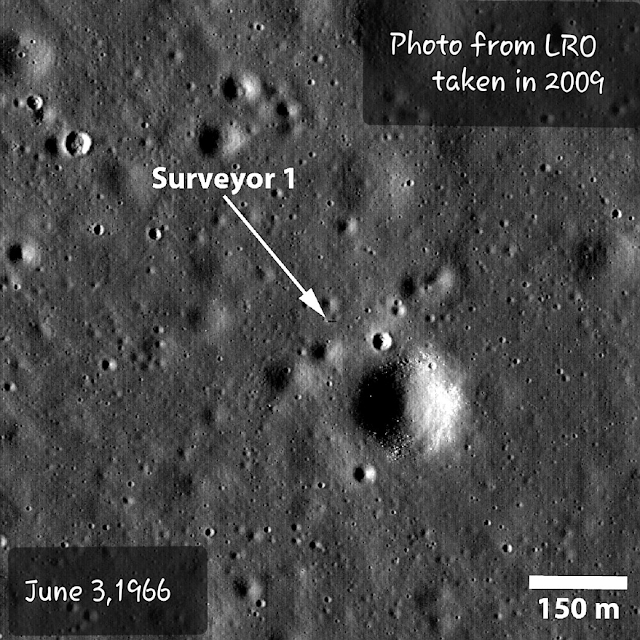©Mark Ollig
The
50th anniversary of the Apollo 11 mission to land the first humans on the moon
is less than two months away.
Three
years before the Apollo 11’s lunar module (named Eagle) successfully touched
down on the lunar surface, another NASA spacecraft had already safely landed.
Named
Surveyor 1, this robotic lunar lander was launched May 30, 1966, from the Cape
Canaveral Air Force Station in Florida.
June
3, 1966, Surveyor 1 fired its retrorocket and three thrusters as it descended
toward the moon’s surface. Its speed slowed to 3 mph as it gently landed on the
moon.
Surveyor
1 had become the first spacecraft launched by NASA to safely land on the moon.
Its
current location is in the Oceanus Procellarum, or “Oceans of Storms.” Looking
at a full moon, its position would be near 9 o’clock.
Surveyor
1’s mission was in preparation for the Apollo moon landings. It contained
scientific instruments for surveying (no pun intended) the moon’s surface,
measuring its temperatures, and using onboard cameras to photograph the lunar
surface.
The
first photo from Surveyor 1 on the surface of the moon confirmed an Apollo
lunar module landing on the moon’s surface would not sink into a top layer of
dust; as some had thought.
Surveyor
1’s landing foot was seen firmly resting atop the lunar soil.
A
total of 11,237 pictures were taken by Surveyor 1.
Communications
between NASA and Surveyor 1 took place using radio-telemetry over NASA’s Deep
Space Network (DSN).
The
DSN is a vast, worldwide array of radio antennas located in California, Spain,
and Australia.
Communication
with NASA’s Earth-orbiting and interplanetary spacecraft is accomplished using
the DSN.
The
Voyager 1 and Voyager 2 spacecraft, launched in 1977, are still communicating
with the DSN several times each week from distances of 11.7 and 9.5 billion
miles, respectively.
July
28, 1964, NASA’s Ranger 7 was launched from Florida and headed toward the moon.
Ranger
7 was not designed to land. Instead, the specific data it obtained was
transmitted to Earth before its mission ended upon impact with the moon’s
surface July 31.
However,
valuable information was obtained from Ranger 7 before its mission ended.
Before
colliding with the moon’s surface, Ranger 7’s six cameras took 4,316
photographs of the lunar surface, which were converted into an RF (radio
frequency) and transmitted to Earth using the spacecraft’s high-gain antenna.
Ranger
7 also took the first photograph of the moon’s surface from a US spacecraft
about 17 minutes before it crashed. You can see the photo here:
https://go.nasa.gov/2EABMrq.
With
only 1,703 feet before impacting the moon in an area called Mare Cognitum,
Ranger 7 took its last two photos of the lunar surface. Those photos can be
seen at https://go.nasa.gov/2Wtgrdo.
Historically,
the world’s first human-made spacecraft to reach (crash) onto the moon’s
surface was named Luna 2, also known as Lunik 2. It was launched by the Soviet
Union Sept. 12, 1959, from Tyuratam, USSR. It crashed on the moon’s surface
Sept. 14.
Before
it crashed, Luna 2’s sensors radioed back to Earth no evidence of a lunar
magnetic field or radiation belt circling the moon.
After
33.5 hours of operation, Luna 2’s radio signals ended, indicating it had
impacted on the moon.
Luna
2 was designed so that upon lunar impact, two pentagonal-shaped titanium
spheres would be scattered across the lunar surface.
The
metallic spheres imprinted in Russian read “CCCP September 1959,” and include a
symbol showing a wreath of grain around a hammer and sickle.
It
is not known whether the two spheres survived or were vaporized when Luna 2
struck the moon at 7,382 mph; the impact temperature was estimated to be over
19,000 degrees Fahrenheit.
Feb.
3, 1966, four months before Surveyor 1, the Soviet Union’s 5-foot
sphere-shaped, Luna 9 robotic lander became the world’s first spacecraft to
successfully soft-land on the surface of the moon.
The
218-pound lander, using its onboard television camera, took several photographs
of the moon’s surface, which were radioed back to Earth.
As
for the Surveyor 1, it stopped operating Jan. 7, 1967; NASA could no longer
receive radio signals from it.
In
2009, NASA’s Lunar Reconnaissance Orbiter photographed Surveyor 1’s current
resting place on the moon’s surface.
In
the photograph, Surveyor 1 is very small; although if you zoom in, the shadow
it casts can be seen. Check it out using this link: https://bit.ly/2Kal8SQ.
NASA’s
Surveyor 3 spacecraft landed on the moon April 20, 1967, and was operational
until May 4.
Nov.
19, 1969, Apollo 12’s lunar module (named Intrepid), landed 525 feet from the
Surveyor 3 spacecraft.
The
two astronauts aboard Intrepid explored Surveyor 3’s landing site during their
second EVA (extravehicular activity).
The
astronauts took photographs and removed electronic parts from the lander to
bring back to Earth for analysis.
 |
| Surveyor 1 |
 |
| Surveyor 3 and Apollo 12 Commander Charles Conrad Jr. (Intrepid lunar module seen in the background) |
 | |
| USSR's Luna 2's pentagonal-shaped titanium spheres |
 | ||
| Photo taken from NASA's Lunar Reconnaissance Orbiter of Surveyor 1 in 2009 |
 | |||||
| Closeup zoom (noticed the shadow cast to the right of Surveyor 1. Photo taken from NASA's Lunar Reconnaissance Orbiter of Surveyor 1 in 2009 |







